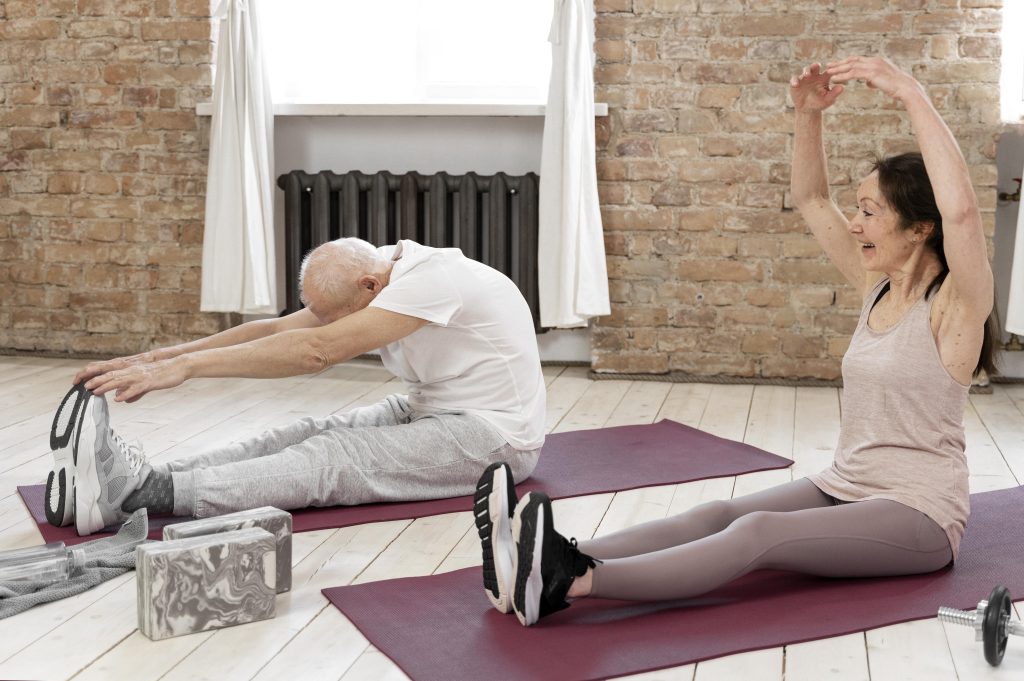How Yoga for Seniors and Respite Care Work Together to Promote Holistic Wellbeing
Chronic pain stiffens joints while stress tightens shoulders, leaving seniors trapped in bodies that feel foreign after decades of faithful service. Family caregivers watch helplessly as their loved ones lose mobility, confidence, and joy while simultaneously burning out from the relentless demands of providing round-the-clock support. Traditional healthcare addresses symptoms with medications and medical appointments, yet something essential remains missing from the equation: a holistic approach that nurtures both physical restoration and emotional peace for everyone involved.
Eleanor’s 82-year-old mother had barely left her chair in months, convinced that movement would worsen her arthritis pain, while Eleanor herself hadn’t slept through the night in over a year of caregiving. When the local senior center introduced chair yoga sessions combined with respite care hours, everything shifted. Mom discovered that gentle stretches actually reduced her joint stiffness and improved her sleep quality, while Eleanor used those precious three hours weekly to attend her own yoga class and reconnect with friends. Within six weeks, both women reported feeling more energized, less anxious, and genuinely excited about their weekly wellness routine that benefited them individually and strengthened their relationship.
The most effective senior wellness programs recognize that sustainable care requires supporting both the receiver and the giver through integrated approaches that address physical, mental, and emotional needs simultaneously. When yoga practice meets respite care planning, families discover that holistic wellbeing becomes achievable rather than aspirational. The combination creates breathing room for healing, growth, and renewed vitality while ensuring that care responsibilities remain manageable and meaningful for everyone involved.
What is Yoga for Seniors?
Yoga is a low-impact activity that emphasizes breathing, flexibility, and balance, making it an ideal activity for older individuals. It helps manage common issues like joint pain, muscle stiffness, and anxiety, while also improving sleep and circulation.
In hospice respite care, modified or adapted yoga practices, such as chair yoga or conscious breathing, offer rest and relief, benefiting both the physical and emotional aspects of care. Easy yoga practices have become an integral part of the general wellness strategy provided to elderly individuals in various senior care settings.
The Emotional Toll of Caregiving and Why Breaks Are Crucial
Taking care of a loved one with a serious illness is both emotionally and physically exhausting. The constant demands can lead to burnout, fatigue, and emotional distress.
Respite care offers temporary relief, allowing caregivers to rest while professionals step in. Whether it’s for a few hours or days, this break—especially when paired with yoga or mindfulness—helps caregivers restore energy and maintain emotional balance, ultimately improving the quality of care they provide.
How Respite Care Supports Holistic Wellness for Seniors
Holistic wellness goes beyond treating illness; it’s about fostering purpose, connection, and comfort, particularly in later life. This can be facilitated by the use of respite care, which is short-term professional care that enables the elderly to be under constant care and also gives the caretaker time to rest.
Seniors not only enjoy socialization, regular structure, healthy eating, and yoga or tai chi, as well as other mind-body practices, in these environments, but all of these activities also help them develop a sense of well-being both physically and emotionally.
Integrating Yoga in Hospice and Respite Settings
Respite and hospice care commonly include such treatments as yoga to foster comfort and wellness. Although yoga is not curative, it can help relieve pain, sleep better, and cope with stress through slow postures and breathing.
Sessions are carefully planned by using soft music and a cushion, as well as guided relaxation, to meet the mental and physical needs of the patients. It aligns with the objectives of hospice respite care, which is concerned with the comfort and quality of life of patients and caregivers.
Benefits for Caregivers and Families
It’s not just seniors who benefit from this combination; family caregivers stand to gain, too. During respite periods, they can attend yoga classes designed for stress relief, helping them regain emotional resilience. Top caregiver benefits include:
- Less anxiety: Yoga helps people stay calm.
- Improved sleeping: This relaxes sleep patterns by stretching the body gently and encouraging breathing.
- Better attention and control of emotions: A necessary precondition to deal with difficult caregiver situations.
- Physical endurance: Caring for another person on a full-time basis is physically demanding; yoga helps keep the body strong and mobile.
Some families even take yoga together at respite time, which gives a chance at bonding and mutual healing.
Tips for Getting Started with Yoga for Seniors
As a caregiver or an aging loved one, it can be scary to start doing yoga, but it does not have to be like that. The following are some tips:
- Start small: Add 5-10 minutes of breathing and stretching, and it helps.
- Use props: Blankets, chairs, and straps can aid movements.
- Seek the perfect teacher: It is good to find a teacher who has been trained in yoga therapy or senior yoga.
- Listen to your body: You need to feel uncomfortable, not in pain. Adjust as necessary.
- Pay attention to focus: Yoga isn’t just movement, try short meditations or gratitude journaling.
Creating a Secure Environment for Yoga & Respite Care
A secure environment is one of the main criteria that make yoga and respite care work with seniors. Sessions are made pleasant with soft lights, a more peaceful environment, and props such as cushions.
The presence of trained instructors and continuous contact between families and the care personnel can guarantee safety and continuity. A friendly environment encourages consistency, faith in the elderly, and general well-being among the seniors and the caregivers.
Creating Sustainable Wellness for the Whole Family
The integration of yoga and respite care represents more than scheduling convenience; it acknowledges that family wellbeing operates as an interconnected system where individual health directly impacts collective harmony. Seniors who engage in regular gentle movement experience improved balance, reduced anxiety, and greater independence, which naturally decreases caregiver stress and prevents burnout. Meanwhile, caregivers who receive consistent respite time return to their responsibilities refreshed, patient, and better equipped to provide compassionate support without sacrificing their own physical and emotional health.
Professional respite care providers trained in senior yoga principles can bridge the gap between therapeutic movement and trusted supervision, ensuring continuity of care while introducing beneficial practices into daily routines. These specialists understand both the physical limitations seniors face and the peace of mind caregivers need when stepping away from their responsibilities. The result is a seamless wellness experience that builds confidence in movement, reduces isolation, and creates positive associations with self-care for entire family units.
Starting this integrated approach requires nothing more than identifying local programs that offer both services or connecting with providers willing to collaborate on scheduling and goals. Many senior centers, assisted living communities, and home health agencies already recognize the value of combining gentle yoga instruction with respite care hours. The families who embrace this dual approach discover that investing in holistic wellbeing pays dividends in improved relationships, better health outcomes, and the sustainable energy needed for long-term caregiving success.






